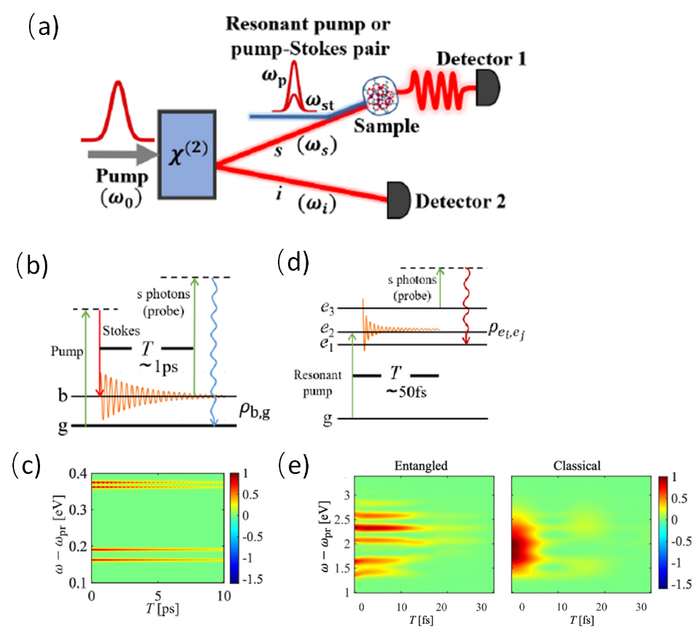Entangled photons, as a prevalent quantum light source, have been extensively employed in quantum communication, quantum imaging, quantum computing, optical interferometry, and other domains.
 (a) Schematic of entangled twin photons as ultrafast probe for molecules, where the parametric down conversion through a beta barium borate (BBO) crystal and multi-photon detection are presented. (b) Level scheme of the microscopic model in Quantum FAST CARS. (c) Quantum FAST CARS signal, taking the 4 Raman-active modes A1, E, and T2 in methane (CH4). (d) Level scheme of microscopic model in QFRS for electronically excited states. (e) Comparison between Intensity-correlated QFRS and classical probe pulse case for the time-evolving electronic coherence as a function of the delay T between the probe photons and the resonant pump pulse. Image Credit: Zhedong Zhang, Tao Peng, Xiaoyu Nie, Girish S Agarwal, and Marlan O Scully.
(a) Schematic of entangled twin photons as ultrafast probe for molecules, where the parametric down conversion through a beta barium borate (BBO) crystal and multi-photon detection are presented. (b) Level scheme of the microscopic model in Quantum FAST CARS. (c) Quantum FAST CARS signal, taking the 4 Raman-active modes A1, E, and T2 in methane (CH4). (d) Level scheme of microscopic model in QFRS for electronically excited states. (e) Comparison between Intensity-correlated QFRS and classical probe pulse case for the time-evolving electronic coherence as a function of the delay T between the probe photons and the resonant pump pulse. Image Credit: Zhedong Zhang, Tao Peng, Xiaoyu Nie, Girish S Agarwal, and Marlan O Scully.
The natural parametric down-conversion produces the entangled photon pairs with momentum and energy conserved so that the quantum correlation in time and space is encoded. Such a feature significantly supports the quantum benefit of surpassing the diffraction limit with classical pulses in the domain of imaging and detection.
One of the long-prevailing bottleneck issues in molecular spectroscopy is sensing ultrafast electronic processes on the femtosecond scale (10-15 seconds). The dynamics of electron coherence are vital on the whole. However, restricted by the incoherent channels of excited states and the time-frequency resolution, current Raman technology cannot be employed to this end.
In a recently-published article in the journal Light Science & Application, Professor Zhedong Zhang from the Department of Physics at the City University of Hong Kong and colleagues have created a femtosecond time-resolved coherent Raman spectroscopy with entangled photons. This paves the way for Quantum femtosecond Raman spectroscopy (QFRS).
A super-resolved nature of the Raman signal ensuing from the exploitation of photon entanglement is demonstrated in their work—both the spectral and temporal resolutions can be realized concurrently. The QFRS is only sensitive to electronic coherence. This renders it exclusively appropriate for sensing the electronically excited-state dynamics during a short timescale ~50 femtoseconds.
This sort of advantage is not achievable in the Raman techniques explored formerly, which were obstructed by either the rapid decay or the time-frequency resolutions. The study provides a new standpoint for examining the ultrafast processes in multifaceted materials such as 2D materials and excitons, molecules, and polaritons, that can be extracted using the preferred relaxation and radiative processes.
The quantum Raman Spectroscopy substitutes the classical probe pulse with a signal-photon beam from the entangled photon source. The idler photon beam acts as the signaled beam for the coincidence measurement. The spectral and temporal resolutions can be thus controlled individually.
This yields the super-resolved nature further than the unifying of the time-frequency relationship. The heterodyne detection can be developed further to track the phase of electrons.
“We design a quantum version of femtosecond Raman spectroscopy for three purposes: (1) to perform high-resolution anti-stokes Raman spectroscopy in real-time domain; (2) to be able to image electron dynamics during ultrashort timescale; and (3) to be sensitive to the phase of molecular excitations so that let the detection sensitivity beat the stand quantum limit.”
“Our work considerably expands the horizon of the entangled light and compliments spectroscopic advances made by entangled light in the context of the optimal two-photon absorption processes in complex molecules. This work will help future experimental and theoretical efforts.” the scientists forecast.
Journal Reference:
Zhang, Z., et al. (2022) Entangled photons enabled time-frequency-resolved coherent Raman spectroscopy and applications to electronic coherences at femtosecond scale. Light Science & Applications. doi.org/10.1038/s41377-022-00953-y.